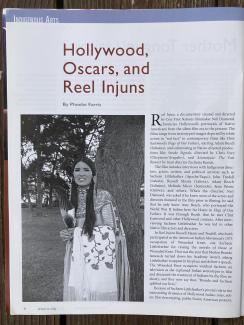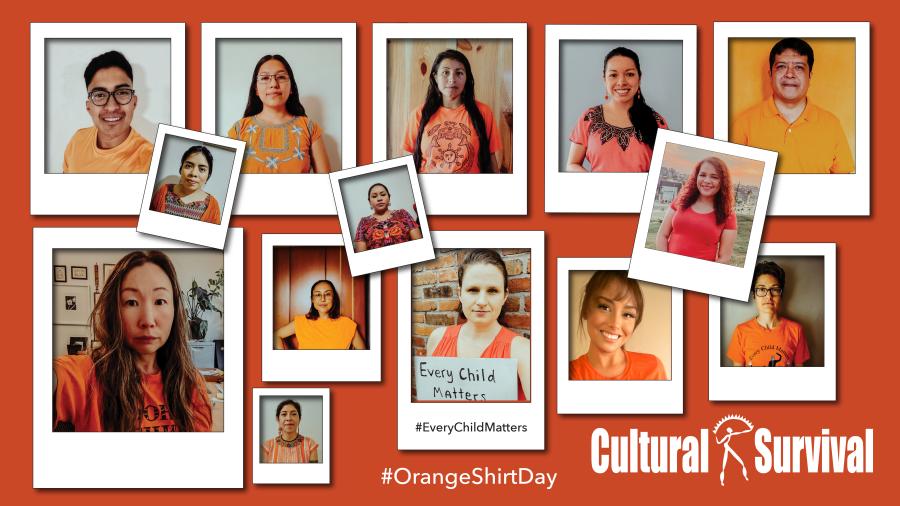
Reel Injun, a documentary created and directed by Cree First Nations filmmaker Neil Diamond, chronicles Hollywood’s portrayals of Native Americans from the silent-film era to the present. The films range from stereotyped images depicted by white actors in “red face” to contemporary films like Clint Eastwood’s Flags of Our Fathers, starring Adam Beach (Salteaux), and culminating in Native-directed productions like Smoke Signals, directed by Chris Eyre (Cheyenne/Arapaho), and Atanarjuat: The Fast Runner by Inuit director Zacharia Kunuk.
The film includes interviews with Indigenous directors, actors, writers, and political activists such as Sacheen Littlefeather (Apache/Yaqui), John Trudell (Lakota), Russell Means (Lakota), Adam Beach (Salteaux), Melinda Micco (Seminole), Jesse Wente (Ojibwe), and others. When the director, Neil Diamond, was asked if he knew most of the actors and directors featured in the film prior to filming, he said that he only knew Amy Beach, who portrayed the World War II Indian hero Ira Hayes in Flags of Our Fathers. It was through Beach that he met Clint Eastwood and other Hollywood contacts. After interviewing Sacheen Littlefeather he was led to other Native film actors and directors.
In Reel Injuns Russell Means and Trudell, who both participated in the American Indian Movement’s 1973 occupation of Wounded Knee, cite Sacheen Littlefeather for raising the morale of those at Wounded Knee. That was the year that Marlon Brando famously turned down his Academy Award, asking Littlefeather to appear in his place and deliver a speech. The Wounded Knee occupiers watched Sacheen on television as she explained Indian stereotypes in film and discussed the treatment of Indians by the film industry, and they now say that, “Brando and Sacheen uplifted our lives.”
Because of Sacheen Littlefeather’s pivotal role in the intersecting dynamics of Hollywood Indian roles, ethnic film stereotyping, public Native American protests, and a new, more progressive era for Native actors, directors, and writers, I decided to interview her for a more in-depth analysis of Reel Injun’s importance. We present some of that interview here.
Phoebe Farris: Can you tell us some of the films you were in and what roles you played?
Sacheen Littlefeather: Some of my films included The Trial of Billy Jack in the ’70s, where I played an Indian attorney and Tom Laughlin was the main actor. I was in Freebie and the Bean as a person in a restaurant with a few lines. That movie starred Walter Mathau. And I played in dubbed Italian westerns because my appearance could also resemble an Italian woman. One of the American westerns where I had a speaking part was Fire Cloud and Winter Hawk. And in the United States I was on the TV show To Tell the Truth and also in a similar game show in Canada.
How did you meet Marlon Brando? Why did he choose you for his Oscar-declining speech?
I met Brando through the director Francis Ford Coppola, who was a neighbor. I wrote letters to Brando about Indian issues, and Coppola introduced us. I was a member of an Indian affirmative action committee to get ethnic actors in Hollywood roles, and I traveled to Washington to make an FCC presentation against movie and TV racial stereotypes that were bad for young ethnic children to watch. Our coalition protested white actors playing ethnic roles, such as a white man playing the Chinese character Charlie Chan. We spoke out against the Frito Bandito, Tokyo Rose as the sneaky Asian traitor, and Indian cartoon characters being played by white actors. The main impact of giving the Oscar speech was that my acting career was cut short, and I was blacklisted, or should I say redlisted? But when I received a call from Coretta Scott King congratulating me on what I did during the Academy Award ceremony, I knew I had done the right thing. When César Chávez called me, I knew I had done the right thing.
Can you tell us about the threats the Oscar officials gave you about reading Brando’s entire speech and the questioning of your Indian identity?
I had only 60 seconds to discuss years of oppression, to express my opinion, which was very heartfelt. The officials told me that I could be pulled off the stage and arrested if I went over 60 seconds. There was tension that night backstage: John Wayne had to be restrained by security men because he was so angry about my presentation. I was the first person to publically stand up alone and make a statement about Hollywood stereotypes. The media accused me of having a false Indian identity, to invalidate the message by invalidating the messenger. I gave the full speech later to reporters, but it got lost in the shuffle—too hot to handle. Recently the full speech came out in the open on the Internet on www.nativevillage.org. The title is “Marlon Brando’s Unfinished Oscar Speech, March 27, 1973.”
What was your overall impression of Reel Injun?
I am so pleased after all these years that a Native American Cree full-blood from Canada, a Cree genius, had such a brilliant idea. It is the culmination of a dream come true for me; to be part of it is a dream come true. I am happy to see Indians now direct, star in, and produce our own films. It is what I wanted, what I always wanted: for us to be able to write and direct and let Natives see ourselves and our viewpoints—how we see ourselves and who we really are as Native peoples.
What segments of Reel Injun made the greatest impression on you? How do you feel about the choice of commentators?
Neil Diamond contacted me, and we met for the first time during the filming process. Neil wanted me to share my viewpoints with the world. I suggested Indian comedian Charlie Hill, John Trudell, and professor Melinda Micco to Neil. I thought Micco would add a scholarly voice. The film connects the dots with my part at the Academy Awards and its meaning for Russell Means and those others at Wounded Knee. My Oscar statement was a pivotal point in Native history and reflected what happened in Hollywood before this current phase of more multicultural filmmaking. It was the first time for public acknowledgement that white actors should not play Indian roles. According to Russell Means’ statements in Reel Injun, my Oscar appearance helped the Wounded Knee occupation get more media attention. Indians were news!
There has been a lot of buzz in Washington about Reel Injun, and it had four locations for viewing in October, prior to its showing on PBS in November. Has the film generated excitement in California? What do you hope the film will accomplish for Native American viewers and for the general public?
Like D.C., California is promoting the film. The Southern California Indian Conference will show it, and it previewed at the Toronto International Film Festival and was sold out. The film opened the Imagine Native Film Festival, which is the largest Native film festival in the world and covers all Aboriginal peoples and has Native producers. The Imagine Native Film Festival is also in Canada. In November, Reel Injun will be shown at the American Indian Film Festival in San Francisco, and it will also be shown in Oakland, California, schools followed by a question-and-answer period. As a side note, Neil Diamond wrote the song “Marlon Brando, Pocahontas, and Me” for the Canadian Indian film The Fast Runner. For me, Reel Injun was a validation, a validation for all Native viewers.



